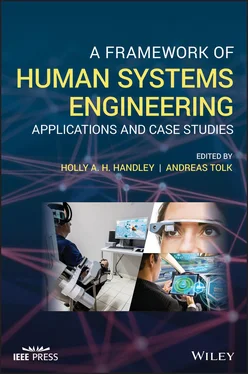A Framework of Human Systems Engineering
Здесь есть возможность читать онлайн «A Framework of Human Systems Engineering» — ознакомительный отрывок электронной книги совершенно бесплатно, а после прочтения отрывка купить полную версию. В некоторых случаях можно слушать аудио, скачать через торрент в формате fb2 и присутствует краткое содержание. Жанр: unrecognised, на английском языке. Описание произведения, (предисловие) а так же отзывы посетителей доступны на портале библиотеки ЛибКат.
- Название:A Framework of Human Systems Engineering
- Автор:
- Жанр:
- Год:неизвестен
- ISBN:нет данных
- Рейтинг книги:4 / 5. Голосов: 1
-
Избранное:Добавить в избранное
- Отзывы:
-
Ваша оценка:
- 80
- 1
- 2
- 3
- 4
- 5
A Framework of Human Systems Engineering: краткое содержание, описание и аннотация
Предлагаем к чтению аннотацию, описание, краткое содержание или предисловие (зависит от того, что написал сам автор книги «A Framework of Human Systems Engineering»). Если вы не нашли необходимую информацию о книге — напишите в комментариях, мы постараемся отыскать её.
A Framework of Human Systems Engineering
Applications and Case Studies
A Framework of Human Systems Engineering: Applications and Case Studies
A Framework of Human Systems Engineering — читать онлайн ознакомительный отрывок
Ниже представлен текст книги, разбитый по страницам. Система сохранения места последней прочитанной страницы, позволяет с удобством читать онлайн бесплатно книгу «A Framework of Human Systems Engineering», без необходимости каждый раз заново искать на чём Вы остановились. Поставьте закладку, и сможете в любой момент перейти на страницу, на которой закончили чтение.
Интервал:
Закладка:
2.4 Deep Dive on Human Interface Considerations
With the advent of IoT sensors and significant increases in capabilities for both connectivity and storage, big data has become the prime dependency for many new technologies and solutions, especially SA. In public safety, and more particularly with first responders, the sheer breadth of information available is overwhelming. Designing human system interfaces that can retrieve, parse, and organize relevant data based on real‐time activities and events, as well as present it in a meaningful, concise, and unintrusive (yet attentive) way, is a defining challenge.
At its core, public safety focused SA is predicated on alerting to noteworthy events in real time while increasing the knowledge and expanding the experience of responding personnel by drawing upon all pertinent historical, concurrent, and predictive information available to the agency. With a primary focus on officer safety, users of this system only have a few minutes upon being notified of the event to ingest the relevant data, make a determination on tactics, and adjust their response accordingly. This is all while they are also driving, communicating with dispatch, and coordinating with colleagues and supervisors. As such, the intelligence generated and presented must offer substantive benefits as rapidly and concisely as possible. The immediate goal of all first responders is to protect life, and much of the data available to police departments can support key areas such as subject identification, threat assessment, and response tactics, all of which greatly enhance SA and help to keep everyone safe.
Machine‐assisted data retrieval, organization, and presentation not only improve the safety of all those involved, but it supports officer decision making by informing them of supplementary details and historical activities and actions. These characteristics are unique to every call for service, and a better understanding of them within the context of the current interaction is invaluable. However, the same mechanisms that collate the appropriate information must also exclude the rest. Considering the highly mobile nature of first responders and the inherent limitations of portable hardware in a public safety setting, it is not practical to expose all associated data, even if it could potentially be relevant in some ancillary contexts. Conversely, ignoring that information has its own tangible detriments, most notably, indicating an incorrect narrative to responding personnel that causes them to make poor judgments that have lasting impacts.
Computers have a unique ability to project truth, regardless of the quality and completeness of the underlying data. This “machine heuristic” 6 easily combines with algorithmic bias, which can corrupt the decision‐making process for first responders with little apparency. As an example, domestic violence incidents are some of the most volatile and dangerous in policing and one in which historical context can greatly sharpen the officer's picture of the situation. Here, the prioritization of arrest history of the involved individuals would seem prudent, since it can assist with the identification of the primary aggressor. However, if that lessens the visibility, or excludes completely, non‐arrest situations where the incident was resolved without enforcement action, it can skew the opinion of the officer prior to the interaction. In a public safety context, there is no single right answer. Extreme care must be given to ensure that relevant data sources are identified through a careful review by experienced personnel, that the presentation and prioritization is tailored to the specific situation, and that the assumptions exhibited are revisited frequently as part of a never ending cycle of improvement.
2.5 Putting Human Interface Considerations in Context: Safe Cities
Public safety is a team effort. First responders do not work in a silo, but rather, they communicate regularly with dispatch, supervisors, operation centers, and a multitude of others. Additionally, support organizations may receive nonemergency tasks and follow‐ups related to the work of those responding personnel. While the first responder in the field, that same data being leveraged for officer safety and rapid decision making is being reorganized and expanded to support the medium and long‐term goals of the agency. Specifically, frontline supervisors will monitor the duration and amount of resources allocated to ensure continued coverage for this and other potential incidents; commanders will want to immediately recognize and respond to trends; operation centers will coordinate the response of supplemental agencies when required. All of these moving parts will leverage the same pool of data in dramatically different ways. In addition, many of these partners will have a broader picture of an incident, as they have the time and space to ingest more information and make more meaningful connections among the disparate sources. As such, human interfaces built around public safety data must support staff in many positions and at all levels of an organization.
All of the dependencies on data mean that there are real and significant impacts to public safety when that information is wrong. Historically, government has been very good about ensuring there is documentation of incidents, actions, and outcomes; however, the quality of that documentation varies wildly. Data can be incomplete, poorly structured, badly transcribed, or any combination thereof. Any of these deficiencies will inherently flow down to SA and data democratization platforms, where their inaccuracies will distract and delay the efforts of public safety professionals at best or compromise them completely at worst. Separately, with the explosion of IoT sensor platforms, such as gunfire detection, license plate recognition, video analytics, etc., the accuracy and pertinence of real‐time alerts are just as important. For example, acoustic gunfire detection draws attention to shootings faster than any witness phone call. However, if those alerts are frequently inaccurate, the data itself becomes meaningless. False alarms become background noise, and the system is ignored. Worse, responding personnel become distrusting of the data, increasing the risk to their personal safety through complacency. Sensor limitations and bad data will likely slow the advancement of automation and enforce human independence for the foreseeable future.
While legacy data may contain inaccuracies and some sensors themselves may have a high false positive rate, human system interfaces are increasingly becoming smarter gatekeepers. The failings of the underlying technology and information are being counterbalanced through sheer volume. Individual data points may be important within the context of a single event, but it is the aggregation of these elements that build complex trend and pattern of life analyses. Here, individual errors are drowned out, and modern visualization solutions present this intelligence in a human‐readable and actionable format. What started as a method to present real‐time information to a user in order to address a specific incident has grown into an endless parade of data that can be stored indefinitely.
This boundless repository of information brings with it a host of security, policy, and legal concerns. Law enforcement is increasingly becoming augmented through technology, which often evolves faster than the necessary companion legislative changes, privacy guidelines, and security enhancements. Beyond the straightforward need to minimize the exposure of this data outside of its intended distribution, there must be controls within the organization as well, maintaining the concept of “need to know.” Access itself should be routinely audited, reviewed, and revised, with secure mechanisms for data distribution and sharing. Just as important as the technical solutions, policy and procedures set a sturdy foundation for an organization's data security. In addition, having a written policy that has been properly vetted, reviewed, and socialized outside of the organization will express to the general public that the security of what is inherently their data is taken seriously. It also provides a roadmap for how to handle data breaches and inadvertent disclosures. Notably, with such large datasets, bad actors no longer require personally identifiable information (PII), like names or social security numbers. Rather, they can cause significant harm through anonymized sources with techniques such as data reidentification. As such, all data can be vulnerable to targeting and must be treated with as much care as traditional PII.
Читать дальшеИнтервал:
Закладка:
Похожие книги на «A Framework of Human Systems Engineering»
Представляем Вашему вниманию похожие книги на «A Framework of Human Systems Engineering» списком для выбора. Мы отобрали схожую по названию и смыслу литературу в надежде предоставить читателям больше вариантов отыскать новые, интересные, ещё непрочитанные произведения.
Обсуждение, отзывы о книге «A Framework of Human Systems Engineering» и просто собственные мнения читателей. Оставьте ваши комментарии, напишите, что Вы думаете о произведении, его смысле или главных героях. Укажите что конкретно понравилось, а что нет, и почему Вы так считаете.












